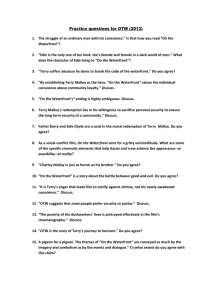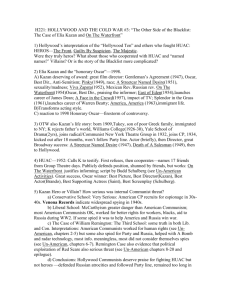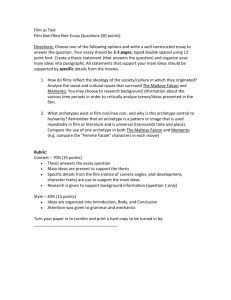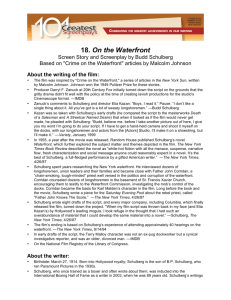On the Waterfront - Noir City Sentinel - Vol. 5
advertisement
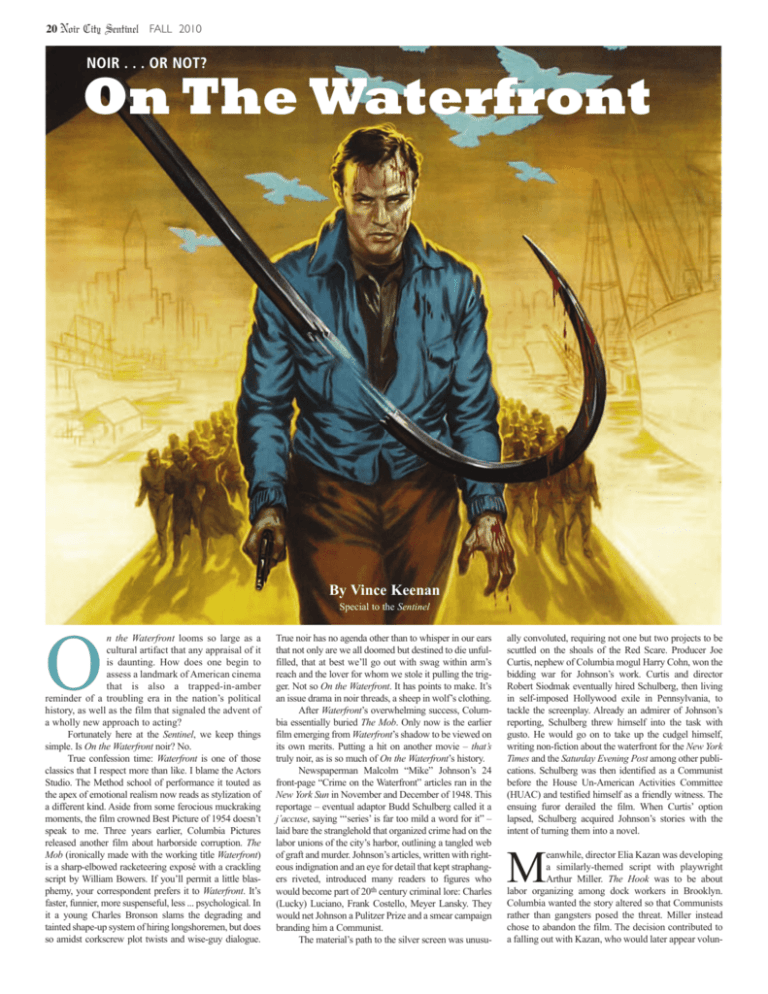
20 Noir City Sentinel FALL 2010 NOIR . . . OR NOT? on the Waterfront By Vince Keenan Special to the Sentinel O n the Waterfront looms so large as a cultural artifact that any appraisal of it is daunting. How does one begin to assess a landmark of American cinema that is also a trapped-in-amber reminder of a troubling era in the nation’s political history, as well as the film that signaled the advent of a wholly new approach to acting? Fortunately here at the Sentinel, we keep things simple. Is On the Waterfront noir? No. True confession time: Waterfront is one of those classics that I respect more than like. I blame the Actors Studio. The Method school of performance it touted as the apex of emotional realism now reads as stylization of a different kind. Aside from some ferocious muckraking moments, the film crowned Best Picture of 1954 doesn’t speak to me. Three years earlier, Columbia Pictures released another film about harborside corruption. The Mob (ironically made with the working title Waterfront) is a sharp-elbowed racketeering exposé with a crackling script by William Bowers. If you’ll permit a little blasphemy, your correspondent prefers it to Waterfront. It’s faster, funnier, more suspenseful, less ... psychological. In it a young Charles Bronson slams the degrading and tainted shape-up system of hiring longshoremen, but does so amidst corkscrew plot twists and wise-guy dialogue. True noir has no agenda other than to whisper in our ears that not only are we all doomed but destined to die unfulfilled, that at best we’ll go out with swag within arm’s reach and the lover for whom we stole it pulling the trigger. Not so On the Waterfront. It has points to make. It’s an issue drama in noir threads, a sheep in wolf’s clothing. After Waterfront’s overwhelming success, Columbia essentially buried The Mob. Only now is the earlier film emerging from Waterfront’s shadow to be viewed on its own merits. Putting a hit on another movie – that’s truly noir, as is so much of On the Waterfront’s history. Newspaperman Malcolm “Mike” Johnson’s 24 front-page “Crime on the Waterfront” articles ran in the New York Sun in November and December of 1948. This reportage – eventual adaptor Budd Schulberg called it a j’accuse, saying “‘series’ is far too mild a word for it” – laid bare the stranglehold that organized crime had on the labor unions of the city’s harbor, outlining a tangled web of graft and murder. Johnson’s articles, written with righteous indignation and an eye for detail that kept straphangers riveted, introduced many readers to figures who would become part of 20th century criminal lore: Charles (Lucky) Luciano, Frank Costello, Meyer Lansky. They would net Johnson a Pulitzer Prize and a smear campaign branding him a Communist. The material’s path to the silver screen was unusu- ally convoluted, requiring not one but two projects to be scuttled on the shoals of the Red Scare. Producer Joe Curtis, nephew of Columbia mogul Harry Cohn, won the bidding war for Johnson’s work. Curtis and director Robert Siodmak eventually hired Schulberg, then living in self-imposed Hollywood exile in Pennsylvania, to tackle the screenplay. Already an admirer of Johnson’s reporting, Schulberg threw himself into the task with gusto. He would go on to take up the cudgel himself, writing non-fiction about the waterfront for the New York Times and the Saturday Evening Post among other publications. Schulberg was then identified as a Communist before the House Un-American Activities Committee (HUAC) and testified himself as a friendly witness. The ensuing furor derailed the film. When Curtis’ option lapsed, Schulberg acquired Johnson’s stories with the intent of turning them into a novel. M eanwhile, director Elia Kazan was developing a similarly-themed script with playwright Arthur Miller. The Hook was to be about labor organizing among dock workers in Brooklyn. Columbia wanted the story altered so that Communists rather than gangsters posed the threat. Miller instead chose to abandon the film. The decision contributed to a falling out with Kazan, who would later appear volun- FALL 2010 Noir City Sentinel 21 tarily before HUAC and name others who had been members of the Communist Party. (Miller would return to The Hook’s setting with A View from the Bridge, about a stevedore who informs on his own kin.) Kazan sought out Schulberg to collaborate on what the writer described as “a film set entirely on the East Coast, based on some pressing social issue.” They naturally gravitated toward the waterfront that had intrigued them both. In spite of Kazan’s then-charmed reputation, the project was spurned by every studio. Particularly galling was the reaction from Kazan’s home at 20th Century Fox. Darryl Zanuck didn’t see the appeal of “a bunch of sweaty longshoremen” and warned the director in a February 1953 memo not to “hit everything on the head and get up on a soap box ... There is no use in making a wonderful picture like (Viva) Zapata, which nobody comes to see except the intelligentsia.” Only a chance encounter with independent producer Sam Spiegel in the Beverly Hills Hotel salvaged the project. Spiegel set up the movie at United Artists, eventually shifting it to Columbia once he’d landed Marlon Brando, his first choice for the lead role. (The actor initially passed. Schulberg, deploying an old OSS trick of inserting bits of paper between the pages, deduced that Brando had never opened the script.) Battles still raged behind the scenes; Frank Sinatra, who’d made a handshake deal to star after Brando declined, sued Spiegel, as would Robert Siodmak when his contributions to Schulberg’s script went unacknowledged. On the streets of Hoboken, New Jersey where Waterfront was filmed, however, Kazan was in complete control. One almost wishes the director had been forced to make good on his threat to grab a 16mm camera and a band of actors if the money fell through. His seat-of-the-pants ingenuity in adding a venetian blind to a taxi set when Spiegel neglected to provide rear projection equipment rescued the iconic “I coulda been a contender” scene. The authentic locations, from cramped tenements to the desperate grandeur of the local church, convey a palpable sense of lives and livelihoods in the balance. The screen is electric with menace whenever Johnson’s reporting is put on its feet: the opening murder of Joey Doyle, a longshoreman cooperating with a criminal investigation of the rackets; mob enforcers raising a ruckus to intimidate workers who have dared to gather in the church; the chaotic shape-up, as the coveted brass tabs guaranteeing a day’s pay are tossed into a frenzied crowd. A hardscrabble milieu meticulously rendered, beset by cruel fates and betrayals large and small. So why isn’t it noir? According to FNF honcho Eddie Muller, noir is when the main character knows what he’s doing is wrong – and does it anyway. By that definition, Brando’s Terry Malloy is no noir protagonist. A former prizefighter who’s had his bell rung too many times, Terry is kept around as the local union’s mascot by kingpin Johnny Kazan directs Brando on location Lee J. Cobb, Marlon Brando, and Rod Steiger: Method to their melodrama Friendly (Lee J. Cobb). Poor battered Terry goes beyond the neighborhood’s “D&D” attitude – “deef and dumb” – toward the corrupt system that holds sway on the harbor. He’s only dimly aware of the scope of the Mob’s crimes, enough to be a threat to the syndicate but not so bent the audience can’t embrace him. Consider his constant protests once he understands that he was used to lure Joey Doyle to his death: “I thought they were gonna talk to him … I thought the worst they were gonna do was maybe lean on him a little bit.” Terry’s punchiness elevates him to the level of an innocent. Terry isn’t tempted by a femme fatale, but a person even more pure than he is. Edie Doyle, Joey’s grieving little sister, is played by Eva Marie Saint in her film debut. Her need to learn who killed her brother makes Terry question the life he’s never given much thought to before. It’s this love story, heartfelt though it is, that bogs the film down for me. The blossoming relationship between the virginal schoolgirl and the saintly palooka is idealized to a fault, at once implausible and calculated. W aterfront is pure noir, however, every second that Terry’s big brother is onscreen. Charley the Gent (Rod Steiger), low-rent consigliore to Johnny Friendly, knows exactly what he and his cohorts are doing and the toll it’s taking on their fellow man. Watch a lifetime of guilt and regret seep out of him like sap from a spiked tree during that famous cab ride. Charley tries to intimidate Terry at the point of a gun, but the kid’s more hurt than scared. “You was my brother, Charley. You should of looked out for me a little bit.” Steiger, an actor whose histrionics can be unbearable, has never been better. Maybe because he had real world resentment to draw on; in his close-ups he’s acting opposite Kazan, as Brando left the set early to see his analyst. Like so many nearly-noirs, Waterfront would fit neatly into the category with a shift in viewpoint. Make it Charley’s story and there would be no doubt. Then there’s the form’s more existential stripe, in which the protagonist is ground down by forces larger than him, doomed before he ever began. On the Waterfront doesn’t qualify on that score, either. Terry Malloy not only prevails but brings the entire dirty system down around him. True, he has to endure a Mel Gibson-level beating first. His longshoremen compatriots stand idly by, rallying to his side only when it’s clear they can defy Johnny Friendly without losing their jobs. It’s a crowdpleaser of a climax that makes thematic but not narrative sense, and speaks ill of the workers it purports to lionize. Schulberg was not a proponent of the ending, and jettisoned it when given the opportunity. In 1955 he published Waterfront, a novel – “no ‘novelization,’ that bastard word for a bastard by-product of Hollywood success” – that “gave me a second chance to put my waterfront experience in perspective.” It also reveals Schulberg’s true allegiance; Father Barry, the crusading priest played by Karl Malden and inspired by real-life reformer the Reverend John M. Corridan, is allowed “to share the action with Terry and to dominate the thinking of the book ... the violent action line of Terry Malloy is now seen for what it is, one of the many moral crises in the spiritual and social development of Father Barry.” And its denouement is considerably grimmer. There is no triumphant march into the warehouse. Terry Malloy is brutally murdered, his “lime-mutilated corpse ... never identified. But the boys along River Street, pro mob and anti, knew they had seen the last of a pretty tough kid.” Father Barry is left facing the prospect of transfer to a parish where he can be easily muzzled. The novel is at times too strenuously naturalist and overindulges Schulberg’s penchant for dialect (“I got a poimanent groove in m’shoulder from too many years of bananers”), but it’s far more clear-eyed. Change is coming to the waterfront, but over time and only at the expense of brave men’s lives. Any discussion of On the Waterfront must address its politics – whatever they may be. It’s difficult to avoid viewing the movie through the prism of its makers’ actions during the HUAC witch hunts. Is it an apologia for informing? Kazan endorsed that interpretation, saying, “On The Waterfront was my own story. Every day I worked on that film I was telling the world where I stood and my critics to go and fuck themselves.” He felt “what made the film strong” was “I did not duck the parallel, I admitted it and stressed it.” Years later, though, the director opined that any comparison between Terry’s predicament and his own “falls short. I always felt my situation had values on both sides (while) the issue in the film is terribly clear.” For a movie not explicitly about the blacklist, Waterfront has had a lengthy afterlife as one that frames the issues of that shameful chapter of Hollywood history. Kazan, in exploring if not obliquely justifying his behavior, has guaranteed that generations of people spared the hard choices that confronted him will forever probe his motivations. There’s something very noir about that. On the Waterfront waters down the strong stuff for public consumption. It raises tough questions only to offer reassuring answers. True love blooms in desolation, the good guys always win. Maybe it’s not noir. The world that spawned it was noir enough. n

